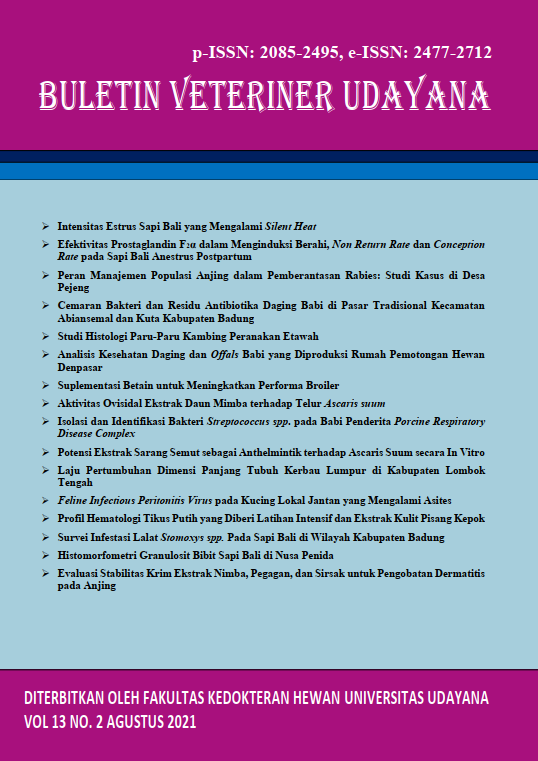THE ROLE OF DOG POPULATION MANAGEMENT IN ERADICATION OF RABIES: CASE STUDY IN PEJENG VILLAGE, TAMPAKSIRING DISTRICT, GIANYAR REGENCY, BALI PROVINCE
Abstract
Since 2008, rabies is still endemic in Bali. Dog Population Management is an effort to stabilize the dog population consisting of six components: education, legislation, identification and registration, vaccination, sterilization, and waste management in eradicating rabies. This program was implemented in Pejeng Village, Tampaksiring District, Gianyar Regency, Bali Province in November 2016, funded by Food and Agriculture Organization. This study aims to determine changes in knowledge, attitudes and ways of raising dogs in the community in the village of Pejeng after the application of Dog Population Management. This observational study uses a cross-sectional study through observation and dissemination of questionnaires directly to the field. The sampling technique uses probability sampling, a proportional stratified sampling technique with the number of samples was 313 respondents. It was conducted in November 2016 (before the Dog Population Management was implemented) and in September 2018 after the Dog Population Management was applied). The collected data were analyzed descriptively. The results before and after the application of Dog Population Management were analyzed by non-parametric analysis using the Wilcoxon test. Based on the results of this study, it was concluded that the Application of Dog Population Management significantly (P<0,05) could change knowledge, attitudes and ways of raising dogs in the community in Pejeng Village better than before.
Downloads
References
Dinas Peternakan dan Kesehatan Hewan Provinsi Bali. 2019. Laporan Kasus Positif Rabies dari Bulan Januari sampai dengan Bulan Agustus 2019. Gianyar. Bali.
Direktorat Jenderal Peternakan dan Kesehatan Hewan. 2015. Pedoman Pengendalian dan Penanggulangan Rabies. Jakarta.
Food and Agriculture Organizations (FAO). 2016. Terms of Reference Initial Phase Implementation Dog Population Management Programme Pilot Project to Optimize Rabies Eradication in Bali.
Gilang GIKR. 2015. Analisis dan faktor risiko yang berhubungan dengan gigitan anjing rabies di Provinsi Bali Tahun 2013. Tesis. Denpasar: Universitas Udayana.
Murphy FA, Gibbs EPJ, Horzinek MC, Studdert MJ. 2007. Veterinary Virology. 3rd Ed. London UK. Elsevier Academic Press. Pp. 277-291
Nugraha EY, Batan IW, Kardena IM. 2017. Sistem pemeliharaan anjing dan tingkat pemahaman masyarakat terhadap penyakit rabies di Kabupaten Bangli, Bali.Jurnal Veteriner.18(2): 274-282.
Parwata AAGO. 2007. Memahami awig-awig desa pekraman, dalam I Ketut Sudantra dan A.A Gede Oka Parwata (ed): Wicara Lan Pamidanda, Pemberdayaan Desa Pakraman dalam Penyelesaian Perkara di Luar Pengadilan, Upada Sastra Denpasar.
Kardiwinata MP, Sutarga M, Subrata M, Suariyani NLP. 2012. Sistem pemeliharaan anjing sebagai salah satu hewan penular rabies pada penderita rabies di Provinsi Bali tahun 2011. Indonesia J. Pub. Health. 1(1): 50-54.
Prayoga IMA. 2018. Perarem menstimulasi masyarakat untuk memelihara anjing dengan baik sebagai upaya penanggulangan rabies di Bali. Tesis. Denpasar: Universitas Udayana.
Putra AAG. 2012. Bali belum bebas rabies. 4500 gigitan anjing per-bulan. rilis pidato ilmiah dies ke-66 Fakultas Kedokteran Hewan UGM, https://ugm.ac.id/id/berita/45234500.gigitan.anjing.per.bulan.bali.belum.bebas.rabies.
Radostits OM, Gay CC, Hinchcliff KW, Constable PD. 2007. Veterinary medicine: a textbook of the diseases of cattle, horses, sheep, pigs and goats.10th Ed. London. Saunders. Pp. 1384-1394.
Saputra IGNAWA, Dibia IN, Puja IK. 2015. Faktor risiko dan penyebaran spasial rabies di Bali pada Tahun 2014. J Ilmu Kesehatan Hewan. 3(2): 69-72.
Suartha IN, Anthara MS, Dewi NMRK, Wirata IW, Mahardika GNK, Dharmayudha AAGO, Sudimartini LM. 2014. Perhatian pemilik anjing dalam mendukung Bali bebas rabies. Buletin Veterner Udayana. 6(1): 87-91.
Susilawathi NM, Darwinata AE, Dwija IB, Budayanti NS, Wirasandhi A, Subrata K, Mahardika GNK. 2012. Epidemiological and clinical features of human rabies cases in Bali 2008-2010. BMC Infect. Dis. (12):81.
Trimarchi CV, Smith JS. 2002. Diagnostic Evaluation. In: Jackson AC, Wunner WH. Rabies. London, UK: Elsevier Science (USA), Pp. 308-344.
Wandeler AI. 1995. Ecological and epidemiological data requirements for the planning of dog rabies control. In: Kuwert EM, Koprowski CH, Bögel K, editors. Rabies in the Tropics. Berlin, Heidelberg: Springer-Verlag. Pp. 657–61.
World Health Organization (WHO). 2001. WHO recomended standards and strategies for surveillance, prevention and control of communicable diseases. http://apps.who.int/iris/bitstream/handle/10665/67088/WHO_CDS_CPE_SMT_2001.13.pdf;jsessionid=D8ECE253F46CE7193762AAD3A8018F2A?sequence=1
World Health Organization (WHO). 2005. WHO expert consultation on rabies first report. WHO Technical Report Series 931. Geneva, Switzerland. Pp. 1-121.
Yones I. 2007. Kajian Pengelolaan Sampah Di Kota Ranai Ibu Kota Kabupaten Natuna Propinsi Kepulauan Riau. Universitas Diponogoro. Semarang.





